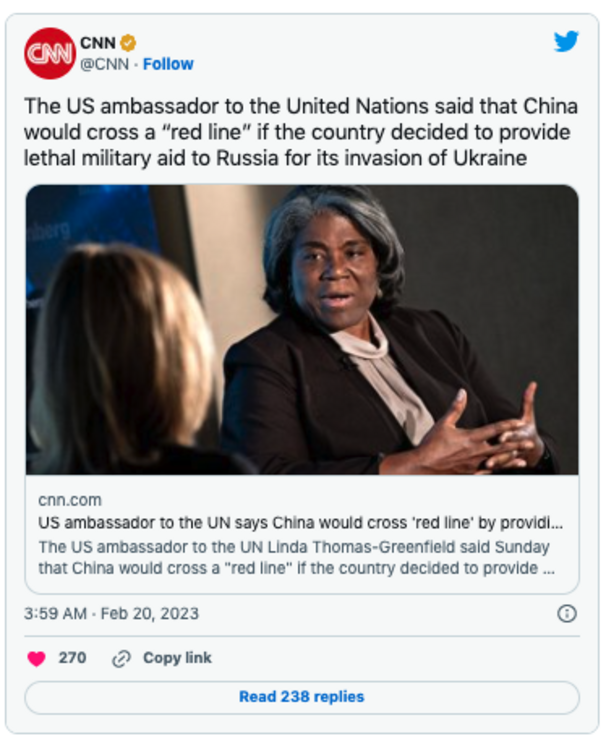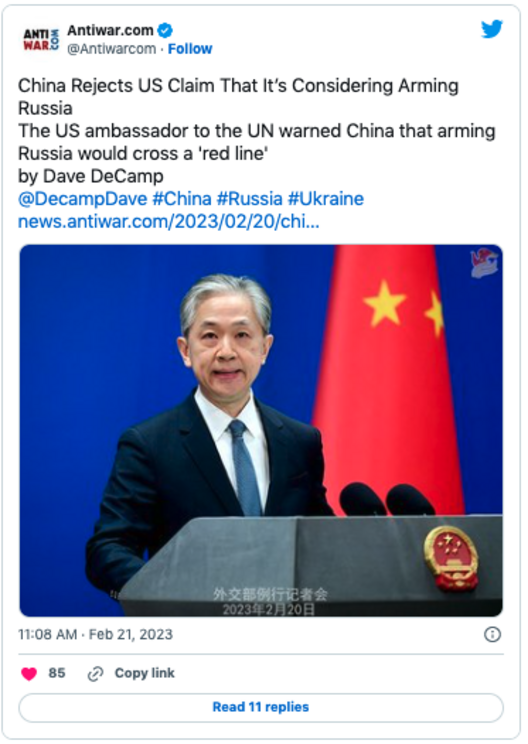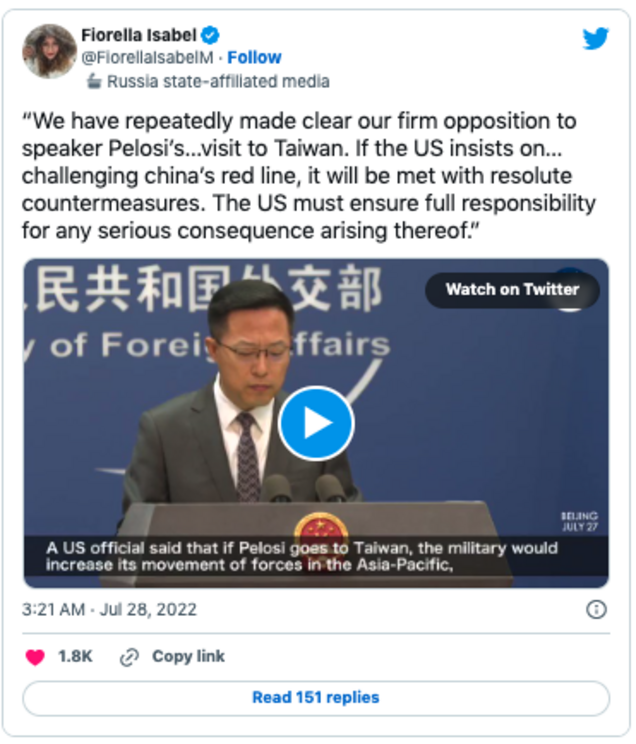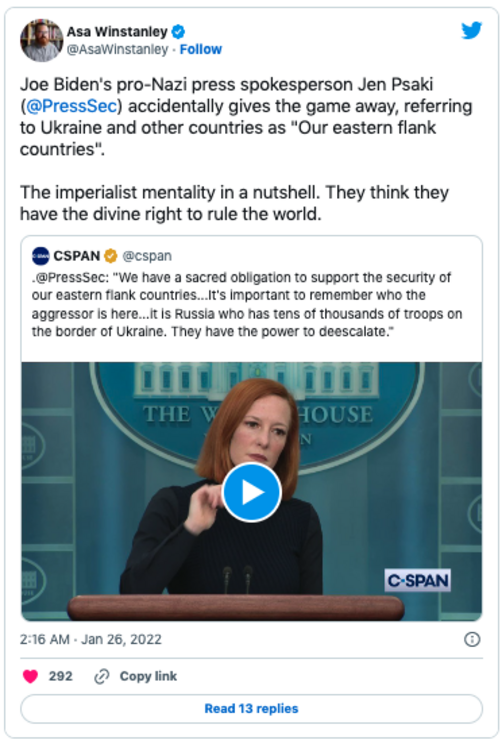Russia and China draw ‘Red Lines’ on their borders
- US draws them on the other side of the Planet
❖
Reacting to China’s announcement that it will be putting forward a proposal for a political settlement to end the war in Ukraine, the US ambassador to the United Nations said that if China begins arming Russia in that conflict this will be a “red line” for the United States.
“We welcome the Chinese announcement that they want peace because that’s what we always want to pursue in situations like this. But we also have to be clear that if there are any thoughts and efforts by the Chinese and others to provide lethal support to the Russians in their brutal attack against Ukraine, that that is unacceptable,” Ambassador Linda Thomas-Greenfield told CNN on Sunday.
“That would be a red line,” she said.
The ambassador’s comments pertained to an unsubstantiated claim made by Secretary of State Antony Blinken on Sunday that China is “considering providing lethal support to Russia in the war against Ukraine,” according to US intelligence.
The US has been making evidence-free claims in relation to China arming Russia against Ukraine since the war began. In March of last year the New York Times reported that “Russia asked China to give it military equipment and support for the war in Ukraine after President Vladimir V. Putin began a full-scale invasion last month, according to U.S. officials.” Then in April of last year NBC reported that this claim “lacked hard evidence” and was essentially just a lie the US government told the media “as part of an information war against Russia.”
The mass media have eagerly participated in promoting this latest re-emergence of narratives about China supplying weapons to Russia, with the Wall Street Journal running a piece just the other day titled “Chinese Drones Still Support Russia’s War in Ukraine, Trade Data Show.” But as commentator Matthew Petti has observed, buried deep in that article is an acknowledgement that these China-made camera drones aren’t even coming from China; they’re being purchased by Russian middlemen in nations like the United Arab Emirates. Really it’s just a story about how China manufactures a lot of products, disguised as something scandalous.
Chinese Foreign Ministry spokesman Wang Wenbin knocked back Blinken’s claims at a press conference shortly after they were made, saying the US is in no position to be accusing anyone of pouring arms into the war.
“It is the US, not China, that has been pouring weapons into the battlefield,” he said. “The US is in no position to tell China what to do. We would never stand for finger-pointing, or even coercion and pressurizing from the US on our relations with Russia.”
Indeed, Washington is warning Beijing with a “red line” against doing something that Washington does constantly, and is currently doing to an unprecedented extent in Ukraine. The US sends weapons to proxy forces all over the world, including to Saudi Arabia in facilitation of its mass atrocities in Yemen, to Al Qaeda and its aligned forces in facilitation of the western dirty war on Syria, and to Israel in facilitation of its apartheid regime and its nonstop attacks on its neighbors. Ukraine is Washington’s biggest proxy warfare operation yet, so it’s a bit rich for it to be drawing “red lines” on the other side of the planet regarding an activity the US spent $113 billion on last year.
And that’s the major difference between the US and nations like Russia and China. When Russia and China draw red lines, it’s at their own borders and regards their own national security interests. When the US draws red lines, it’s far from its own borders and unrelated to the security of the nation.
During the lead-up to the invasion of Ukraine, Putin warned over and over again that the west was taking Moscow’s “red lines” on Ukrainian neutrality too lightly, and Washington brazenly dismissed those warnings while continuing to float the possibility of future NATO membership for Ukraine.
“I don’t accept anybody’s red lines,” President Biden told the press in December of 2021 when asked about the warnings.
Weeks later Putin made good on his threat, launching a horrific war that could easily have been prevented with a little diplomacy and sensibility.
“This is that red line that I talked about multiple times,” Putin said. “They have crossed it.”
Similarly, Beijing has been using the phrase “red line” with regard to Taiwan and the US empire’s rapidly escalating provocations on that front. China used it multiple times last year warning against then-House Speaker Nancy Pelosi’s visit to the island, which Beijing regards as an egregious violation of Washington’s One China policy. As Antiwar’s Dave DeCamp frequently notes, this marked the beginning a new level of hostilities from Beijing which now sees frequent military crossings of the median line between Taiwan and mainland China that weren’t commonplace before.
Whether you agree with Moscow and Beijing about their “red lines” or not, you must concede that there’s a very big difference between the way they draw them and the way the US makes use of that concept. Russia and China are issuing these warnings about the areas immediately adjacent to their own territory, while the US issues them to anyone it likes about what they are permitted to do with their neighbors, even when the US itself engages in those very activities all the time.
Washington literally thinks of this entire planet as its territory. It believes it is its divinely bestowed right to issue decrees about what may and may not be done anywhere in the world, and that any transgression against these decrees is an act of aggression against it.
We see this evidenced in the way US officials talk about the world. Just in January of last year President Biden said that “everything south of the Mexican border is America’s front yard.” That same month then-Press Secretary Jen Psaki remarked on the mounting tensions around Ukraine that it is in America’s interest to support “our eastern flank countries”, which might come as a surprise to those who were taught in school that America’s eastern flank was not eastern Europe but the eastern coastline of the United States. You’ll see the imperial media refer to things like the vague prospect of China maybe someday building a military base in the African nation of Equatorial Guinea as a menacing encroachment upon America’s “backyard”.
It’s just so crazy how the US government has the temerity to publicly rend its garments in outrage over foreign nations making demands about what happens on their own borders while it continually makes demands about what happens everywhere in the world. It wails and moans about its enemies asserting small “spheres of influence” over former Soviet states or the South China Sea, while it itself asserts a sphere of influence that looks like planet Earth.
Whenever you point out how the US is the worst offender in any area it criticizes other governments for you’ll find yourself accused of “whataboutism”, but what this actually means is that you have highlighted evidence that the US does not play by its own rules and does not actually value the issues it’s trying to moralize about. The US is not trying to stop foreign nations from bullying and dominating their neighbors, it’s trying to bash out more space for itself to bully and dominate the world.
...
My work is entirely reader-supported, so if you enjoyed this piece please consider sharing it around, following me on Facebook, Twitter, Soundcloud or YouTube, throwing some money into my tip jar on Ko-fi, Patreon or Paypal, or buying an issue of my monthly zine. If you want to read more you can buy my books. The best way to make sure you see the stuff I publish is to subscribe to the mailing list for at my website or on Substack, which will get you an email notification for everything I publish. Everyone, racist platforms excluded, has my permission to republish, use or translate any part of this work (or anything else I’ve written) in any way they like free of charge. For more info on who I am, where I stand, and what I’m trying to do with this platform, click here. All works co-authored with my husband Tim Foley.
Bitcoin donations:1Ac7PCQXoQoLA9Sh8fhAgiU3PHA2EX5Zm2
Liked it? Take a second to support Caitlin Johnstone on Patreon!

-1677016766372.png?w=992&h=744)



